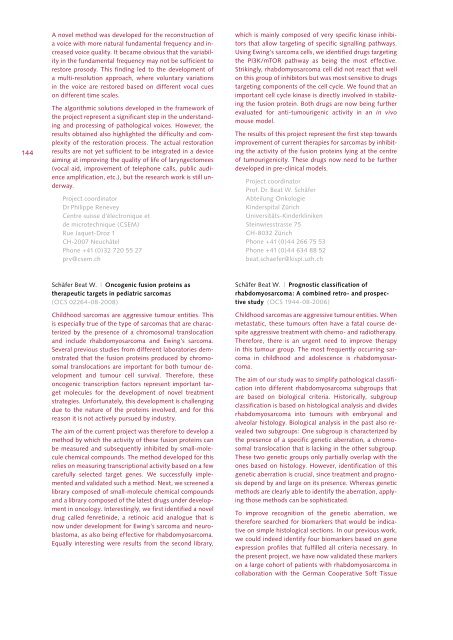Cancer Research in Switzerland - Krebsliga Schweiz
Cancer Research in Switzerland - Krebsliga Schweiz
Cancer Research in Switzerland - Krebsliga Schweiz
You also want an ePaper? Increase the reach of your titles
YUMPU automatically turns print PDFs into web optimized ePapers that Google loves.
144<br />
A novel method was developed for the reconstruction of<br />
a voice with more natural fundamental frequency and <strong>in</strong>creased<br />
voice quality. It became obvious that the variability<br />
<strong>in</strong> the fundamental frequency may not be sufficient to<br />
restore prosody. This f<strong>in</strong>d<strong>in</strong>g led to the development of<br />
a multi-resolution approach, where voluntary variations<br />
<strong>in</strong> the voice are restored based on different vocal cues<br />
on different time scales.<br />
The algorithmic solutions developed <strong>in</strong> the framework of<br />
the project represent a significant step <strong>in</strong> the understand<strong>in</strong>g<br />
and process<strong>in</strong>g of pathological voices. However, the<br />
results obta<strong>in</strong>ed also highlighted the difficulty and complexity<br />
of the restoration process. The actual restoration<br />
results are not yet sufficient to be <strong>in</strong>tegrated <strong>in</strong> a device<br />
aim<strong>in</strong>g at improv<strong>in</strong>g the quality of life of laryngectomees<br />
(vocal aid, improvement of telephone calls, public audience<br />
amplification, etc.), but the research work is still underway.<br />
Project coord<strong>in</strong>ator<br />
Dr Philippe Renevey<br />
Centre suisse d’électronique et<br />
de microtechnique (CSEM)<br />
Rue Jaquet-Droz 1<br />
CH-2007 Neuchâtel<br />
Phone +41 (0)32 720 55 27<br />
prv@csem.ch<br />
Schäfer Beat W. | Oncogenic fusion prote<strong>in</strong>s as<br />
therapeutic targets <strong>in</strong> pediatric sarcomas<br />
(OCS 02264-08-2008)<br />
Childhood sarcomas are aggressive tumour entities. This<br />
is especially true of the type of sarcomas that are characterized<br />
by the presence of a chromosomal translocation<br />
and <strong>in</strong>clude rhabdomyosarcoma and Ew<strong>in</strong>g’s sarcoma.<br />
Several previous studies from different laboratories demonstrated<br />
that the fusion prote<strong>in</strong>s produced by chromosomal<br />
translocations are important for both tumour development<br />
and tumour cell survival. Therefore, these<br />
oncogenic transcription factors represent important target<br />
molecules for the development of novel treatment<br />
strategies. Unfortunately, this development is challeng<strong>in</strong>g<br />
due to the nature of the prote<strong>in</strong>s <strong>in</strong>volved, and for this<br />
reason it is not actively pursued by <strong>in</strong>dustry.<br />
The aim of the current project was therefore to develop a<br />
method by which the activity of these fusion prote<strong>in</strong>s can<br />
be measured and subsequently <strong>in</strong>hibited by small-molecule<br />
chemical compounds. The method developed for this<br />
relies on measur<strong>in</strong>g transcriptional activity based on a few<br />
carefully selected target genes. We successfully implemented<br />
and validated such a method. Next, we screened a<br />
library composed of small-molecule chemical compounds<br />
and a library composed of the latest drugs under development<br />
<strong>in</strong> oncology. Interest<strong>in</strong>gly, we first identified a novel<br />
drug called fenret<strong>in</strong>ide, a ret<strong>in</strong>oic acid analogue that is<br />
now under development for Ew<strong>in</strong>g’s sarcoma and neuroblastoma,<br />
as also be<strong>in</strong>g effective for rhabdomyosarcoma.<br />
Equally <strong>in</strong>terest<strong>in</strong>g were results from the second library,<br />
which is ma<strong>in</strong>ly composed of very specific k<strong>in</strong>ase <strong>in</strong>hibitors<br />
that allow target<strong>in</strong>g of specific signall<strong>in</strong>g pathways.<br />
Us<strong>in</strong>g Ew<strong>in</strong>g’s sarcoma cells, we identified drugs target<strong>in</strong>g<br />
the PI3K/mTOR pathway as be<strong>in</strong>g the most effective.<br />
Strik<strong>in</strong>gly, rhabdomyosarcoma cell did not react that well<br />
on this group of <strong>in</strong>hibitors but was most sensitive to drugs<br />
target<strong>in</strong>g components of the cell cycle. We found that an<br />
important cell cycle k<strong>in</strong>ase is directly <strong>in</strong>volved <strong>in</strong> stabiliz<strong>in</strong>g<br />
the fusion prote<strong>in</strong>. Both drugs are now be<strong>in</strong>g further<br />
evaluated for anti-tumourigenic activity <strong>in</strong> an <strong>in</strong> vivo<br />
mouse model.<br />
The results of this project represent the first step towards<br />
improvement of current therapies for sarcomas by <strong>in</strong>hibit<strong>in</strong>g<br />
the activity of the fusion prote<strong>in</strong>s ly<strong>in</strong>g at the centre<br />
of tumourigenicity. These drugs now need to be further<br />
developed <strong>in</strong> pre-cl<strong>in</strong>ical models.<br />
Project coord<strong>in</strong>ator<br />
Prof. Dr. Beat W. Schäfer<br />
Abteilung Onkologie<br />
K<strong>in</strong>derspital Zürich<br />
Universitäts-K<strong>in</strong>derkl<strong>in</strong>iken<br />
Ste<strong>in</strong>wiesstrasse 75<br />
CH-8032 Zürich<br />
Phone +41 (0)44 266 75 53<br />
Phone +41 (0)44 634 88 52<br />
beat.schaefer@kispi.uzh.ch<br />
Schäfer Beat W. | Prognostic classification of<br />
rhabdomyosarcoma: A comb<strong>in</strong>ed retro- and prospective<br />
study (OCS 1944-08-2006)<br />
Childhood sarcomas are aggressive tumour entities. When<br />
metastatic, these tumours often have a fatal course despite<br />
aggressive treatment with chemo- and radiotherapy.<br />
Therefore, there is an urgent need to improve therapy<br />
<strong>in</strong> this tumour group. The most frequently occurr<strong>in</strong>g sarcoma<br />
<strong>in</strong> childhood and adolescence is rhabdomyosarcoma.<br />
The aim of our study was to simplify pathological classification<br />
<strong>in</strong>to different rhabdomyosarcoma subgroups that<br />
are based on biological criteria. Historically, subgroup<br />
classification is based on histological analysis and divides<br />
rhabdomyosarcoma <strong>in</strong>to tumours with embryonal and<br />
alveolar histology. Biological analysis <strong>in</strong> the past also revealed<br />
two subgroups: One subgroup is characterized by<br />
the presence of a specific genetic aberration, a chromosomal<br />
translocation that is lack<strong>in</strong>g <strong>in</strong> the other subgroup.<br />
These two genetic groups only partially overlap with the<br />
ones based on histology. However, identification of this<br />
genetic aberration is crucial, s<strong>in</strong>ce treatment and prognosis<br />
depend by and large on its presence. Whereas genetic<br />
methods are clearly able to identify the aberration, apply<strong>in</strong>g<br />
those methods can be sophisticated.<br />
To improve recognition of the genetic aberration, we<br />
therefore searched for biomarkers that would be <strong>in</strong>dicative<br />
on simple histological sections. In our previous work,<br />
we could <strong>in</strong>deed identify four biomarkers based on gene<br />
expression profiles that fulfilled all criteria necessary. In<br />
the present project, we have now validated these markers<br />
on a large cohort of patients with rhabdomyosarcoma <strong>in</strong><br />
collaboration with the German Cooperative Soft Tissue

















